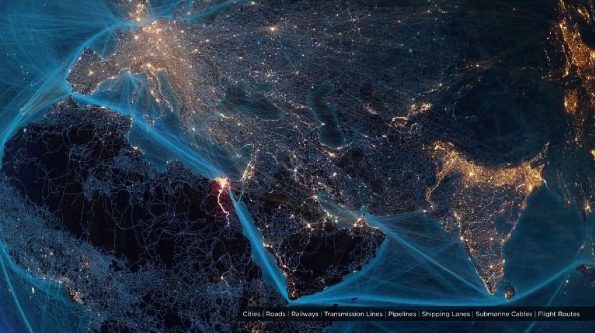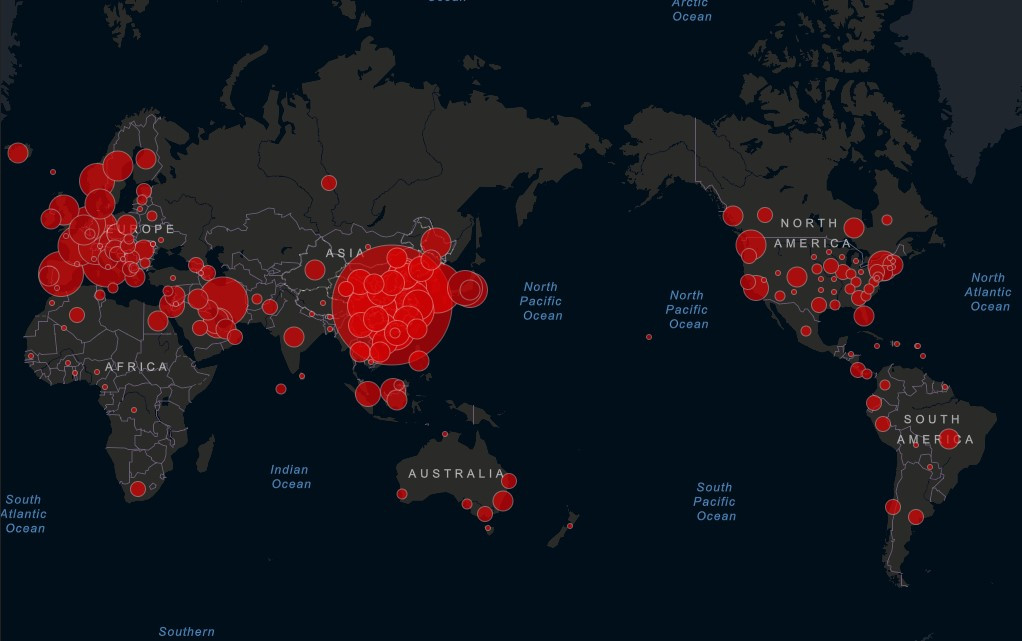Introduction
The more one studies logistics, the more a new way to conceive the world erupts.
In fact, in my mind, researching on logistics is a really productive exercise to elaborate new analytical lenses for the comprehension of the ongoing transformations of contemporary world. Seeing through logistics is an attempt to understand the rhythm of global capitalism, grasping at the same time its never ending movements and its disruptions, following the ways in which logistics produces worlds: Erecting its own borders and infrastructures, managing their contestations and making possible for its circuits to flow.
My hypothesis is that there are many specific overlapping between the logistics evolution and the transformations of the contemporary urban texture. In this sense, I speak of a logistical urbanisation, meaning that during the last century and a half logistics has been a crucial matrix of rationality and a set of tools that have fostered toward the contemporary scenario of the so called “planetary urbanisation”1. So, I think we should consider “logistics as an urban logic”2 in a wide sense.
In this paper I present the draft of a model, an interpretative historical schema based on the non trivial triangle composed by: cities, processes of globalization, and new systems of production. However, the triangle I am depicting has to be taken, to be imagined, in the non-Euclidean geometry framework, which is by definition less close to the human perception. Or, more precisely, we need to look at this plexus of processes in the very same way as Quantum Physics interprets the fundamental nature of particles composing ordinary matter. That is to say: the conceptual galaxy I am going to talk about is not composed by three distinct “classical” points, but rather it is the superposition of overlapping regions that shape a unique conceptual cloud. As a matter of fact, the interconnections between cities, globalization and systems of production are chaotic rather than linear, and logistics is somehow the uneven texture that describes and sustains the concepts produced at the intersection of this field of tensions… In other words, logistics is the hidden fil rouge that connects these different “plans”.
The metaphor of a logistical cloud contains an epistemological assumption. On one hand, I am refering here to the so called “crisis of the cartographic reason” described by many geographers3: a peculiar condition that in my mind starts precisely from the fact that the topology of the sphere (i.e. the globe, globalization) is irreducibly and intrinsically different from that of a flat surface, as the two dimensional space through which we have thought the world by means of maps during the modern era. On the other hand
rather than organizing a stable map of the world, the processes of proliferation and transformation of borders aim to manage the ‘creative destruction’ and constant recombination of spaces and times that lie at the heart of contemporary capitalist globalization4.
The schema I am going to discuss is intended to trace a genealogical root of the correlations between logistics and the territorial transformations. I conclude with some thoughts and an example of one of the new “internal” frontiers of the contemporary urban capitalist expansion, what I call “materializing online logistics” – supporting the thesis that “the background becomes foreground”, that is to say: from an hidden logic of urbanisation production, logistics is becoming the concrete and visible system that drives and organizes what nowadays we call “the urban”.
The background of the model
In 1970 Henri Lefebvre elaborated this schema as an attempt to conceptualize what he called “the urban revolution”.
Today, we are completely entered within the critical zone he foreseen almost 50 years ago. So, it is time to update Lefebvre’s vision.
While Lefebvre basically focused on cities as definite spaces, it is useful to enlarge the picture, considering the political economy of urban socio-technical systems that define the city. Together, the arrangements of hydraulics, different resources, communications and circulation and the like (that it to say: the urban logistical apparatus), instantiate and sustain urban life within and beyond cities in all sort of ways. This gives a more profound idea of the urban logistical system and implies the attempt to expand Lefebvre’s schema to the whole territory.
Moreover, the analytical lens I try to adopt on cities as territorial facts somehow recalls a pre-modern conception of the city. From 1572 to 1617 the topo-geographer Georg Braun edited the Civitates orbis terrarum, an opera containing 546 prospects, bird’s-eye views and maps of cities from all around the world. An examination of this pictures makes immediately visible that cities were not reduced to their simple urban form. Rather, cities are represented as complex sets of people, infrastructures, streets, hinterland and countryside. It is precisely this kind of vision on city we need to recover today.
Four Logistical clouds
1) World-City Cloud 2) Metropolis Cloud 3) Global City Cloud 4) City-World Cloud
-
World-City Cloud
The World-City idea was originally proposed by Fernand Braudel5 to describe the cities that lead the first waves of the European global expansion. We can primary think to cities like London from the Mid XVII, when the city was becoming the heart of a new Empire, the battlefield for the building up of the modern State and the headquarter of many of the most important Corporations. The territorial World-City scenario was that of the early capitalist agriculture, what Karl Marx refers to as “the so called original accumulation”, and the colonization process for the accumulation of raw materials.
Moreover, Giovanni Arrighi frames a series of hegemonic systemic cycles of accumulation that have shaped what he calls the world system6.
Every cycle has a city as its centre. A city that is the logistical and financial engine of that system. This political and mercantile World-City developed simultaneously with the born of modern logistics. At that time the globalizing processes were centred on the Atlantic, and as Harney & Moten write:
Modern logistics is founded with the first great movement of commodities, the ones that could speak. It was founded in the Atlantic slave trade, founded against the Atlantic slave7.
Against the slave: meaning, to control its resistance and rebellion. Just keep in mind this “negative” aspect of logistics, that returns in every cloud.
-
Metropolis Cloud
Against the narrative of an industrial revolution followed by an urban revolution, I argue that urbanization and industrialization are two sides of the same coin. But the equilibrium of their co-evolving process had a break. The historical turning point was the cycle of urban uprisings of 1848. After these insurrections a set of knowledges and practices elaborated and tested mainly in the Colonial spaces, started to be directly applied on cities. Military, trade, infrastructural and circulatory rationalities composed a logistical urban logic, the very foundation of metropolis. The canonical example here is Haussmann works in Paris, the typical reaction to workers insurrection. So, what is remarkable is that metropolis was the result of a huge logistical operation. And, as you can see from the following quote, urban logistics was born against workers insurrections:
The project of the modern city is nothing more than the response, the capital’s response, to class conflict. Le Corbusier well understood when he posed les autorités in front of the dilemma: architecture or revolution8.
Finally, Metropolis has been the subject that pushed the so called “first globalization”. Metropolis is not a World-City and this globalization is more complex than a World-system cycle. Metropolis is at least the embryo of a transnational urban production. Its scenario is that of the large-scale real subsumption of increasing portion of territory through the consolidation of industrialized operational landscapes (especially in agriculture, mining) and the extension of the urban fabric that traverses and fragments the ‘countryside’9.
-
Global City Cloud
If mature metropolis was the impetus of the first globalization, global cities have been the basis of the second globalization. Global cities were the financial directional points of a world that was becoming One, thanks to the logistical worldwide expansion of capitalist production. Again: urbanization and industrialization define the same process of capitalist expansion. The emergent planetary fabric of urbanization is strictly related to the image of a “global factory without walls”10. But, how was the global city built? It is possible to sustain that there is again a logistical technique at its basis. Take New York as an example. Many consider Robert Moses, the New York city planner, the “master builder” of the city after the Great Depression until the late Sixties, as a sort of Haussmann 2.0. It is not a case that he worked during the period of elaboration of the so called “logistics revolution”11.
What drove the logistics revolution? Apart from the technical innovations, I think it is necessary to consider that “in the ’70s capital started to attack the concentrations of working class power that some have called the mass worker”12. It is the factory as a concentration of workers the main objective that logistics revolution targets as the form of production to be overcome. Logistics revolution is in this sense a response to the threat of the organized working class. Maybe we should frame it as a “counter-revolution”.
Anyway, I need to enlighten that the symbol of that era, the factory, has never had a conclusive form. The factory has always been a process of permanent transformation, a centre that continuously re-organizes the territory. Where there is a factory, there is a logistical network that coordinates machines, transports, fluxes of people, rough materials, commodities.
So, when the factory expands its operating range on the whole world, thanks to the logistics revolution, it is the entire global urban tissue that explodes. The result of it is the global cities network formation and the second globalization, the neo-liberal one.
-
City-World Cloud
The fourth logistical cloud, the City-World cloud, is an attempt to describe the contemporary global dynamics, as the output of the global neoliberalization from the 1980s. The scenario is that of the planetary urbanization visualized before: the tendential real subsumption of planetary space and the worldwide extension of industrial production.
The deep crisis of the second globalization is a global cities crisis. There is an evident loss of hegemony of global cities, as the Brexit and the Trump’s elections have made explicit in their geographies of the vote.
So, on one hand there is a tendency toward a city-world, a palindrome form to explain a world that becomes one city and the fact that every city is becoming a world itself. A multi polar world were «cities are the true planetary citizens»13.
A world as a meta-city where every single city is nothing more than a neighbourhood of a unique city.
On the other hand the planetary urbanization, the industrialization of the entire planetary surface, as a consequence of the global cities metabolism. The hinterland is becoming a strategic terrain of capitalist urbanization because it is transformed into an industrialized ‘operational landscape’. A multiplication of heterogeneous spaces of urbanization like the zones of extraction, and increasingly the landscape itself is reorganized and rationalized to maximalize its potential industrial outputs, also thanks to a new global discipline of labour.
So, a City-World described by the tensions between the becoming city of the world and the planetary urbanisation. Here logistics is the analytical perspective that could connect these two conceptions, or, to put it better, the logistical politics of urbanization is the hidden side of the rise of globally-integrated production networks, which are intricately linked to the transformation of economic geographies. Logistics is not any more only a “reaction to”, but assumes a performative profile.
The world as a single city + planetary urbanisation: These are, if you want, the “external” images of contemporary global capitalism. Starting from this contemporary scenario, I conclude by briefly depicting one of the spearheads of this development, one of its “internal frontiers”.
Materializing online logistics – When the background becomes foreground
I cannot depict a general overview, but I would like to focus on a specific analytical angle, from which maybe it is possible to distill some more general tendencies.
Just-in-time production has recreated the city in its image [and as commodities] are shipped from their point of production to the point of sale, they pass through and depend on the urban hubs and bottlenecks of international trade, in turn reshaping the physical layout and the multiscalar governance logics of global cities14.
My thesis is that within logistical worlds there are hidden the new global urban planners. Neither planners and architects nor national or local institutions have nowadays the ideas, the tools, the power, to draw the Plan of development of the urban texture. Logistical actors are playing an urban politics, they have a vision of what is the contemporary territory and they are developing their own idea of the city (if you want, you can call it the “smart city”).
We have to understand that the urban assemblage is itself a political machine – its infrastructures are
de facto forms of polity faster than even quasi-official forms of governance15.
So, along the sequence: “logistics revolution”, “retail revolution”, “new industrial revolution” (or economy 4.0, or digital revolution), the very urban impact of the last transformations is concretely emerging only in the last 5 years more or less. Amazon is the easiest example of this progression.
From an Internet company to a logistics company, in last years Amazon started to “materialize”, building up its own infrastructures. In the United States there is an increasingly differentiation of Amazon Infrastructures:
This set of logistical infrastructures is drawing new cartographies of circulation, as it is possible to appreciate also from a national perspective and from a metropolitan one.
The oldest of the New York Amazon’s building is from 2013. Since than, Amazon centres have proliferated like mushrooms in the urban jungle.
This materializing process, this “becoming-hub” of the cities, is not, of course, only an American process. Piacenza, one of the epicentre of the process of the Italian logistics struggles in the Po valley region (ongoing since almost ten years17) is the headquarter of the first Italian Amazon Fulfillment centre.
This Amazon warehouse opened only two years ago, and since then Amazon is developing an impressive acceleration in the construction of new hubs and local depots, shaping a new urban circulating texture in the area. It is remarkable that also Alibaba, the “Chinese Amazon”, intends to open a one million meters hub in Piacenza. This project is encountering many protests. Moreover, just as a curiosity, Alibaba is in some ways involved in the logistics of migration, selling (mainly in Libya) products like the “Inflatable rescue refugee boat”:
Conclusion
The logistical logic of just-in-time and localization drives a global urban politics and we assist to a tendency towards a becoming-hub of the city.
The new designers of the urban, although within technical lexicons and imaginaries, are bearers of a concrete politics of the city – that is, needless to say, constantly contested, contrasted and counteracted by a myriad of different subjects, either within logistics labour or in the different dwelling practices of metropolitan territories.
The dream, the fantasy of a logistical government of urban processes, incessantly clashes against the conflictual matrix of the urban substance.
The emerging city-world displays a contrast between the depoliticization via technicalization of the logistical production of the urban, on one hand, and the specific tension over autonomy of the city on the other. This friction materializes a claim of power on the globalized city, a contested and continuous production of encounters and clashes, of friendships and hostilities, that demonstrate the need to rethink from the beginning the urban political.
1Brenner N. (ed), Implosion/Explosion. Towards a study of planetary urbanization, Jovis, Berlin, 2013.
2Cuppini N., Logistics as an urban logic – Genealogical insights, working paper presented at the KOSMOS Summer School – Investigating logistics (Berlin, 19-30 September 2016) in the panel Seeing through logistics (https://independentresearcher.academia.edu/Niccol%C3%B2Cuppini).
3See for example Farinelli F., La crisi della ragione cartografica, Einaudi, Torino, 2009; Pickless J., A History of Spaces. Cartographic Reason, Mapping and the Geo-Coded World, Routledge, New York, 2004.
4Mezzadra S. and Neilson B., Between Inclusion and Exclusion: On the Topology of Global Space and borders, in “Theory, Culture & Society”, Vol. 29, Issue 4-5, 2012, p. 64.
5Braudel F., Civilization and Capitalism, 15th-18th Century (Vol. III): The perspective of the world, University of California Press, Berkeley and Los Angeles, 1992.
6Arrighi G., The Long Twentieth Century: Money, Power, and the Origins of Our Times, Verso, London and New York, 1994.
7Harney S. and Moten F., The Undercommons. Fugitive Planning & Black Studies, Minor Composition, Port Watson, 2013, p. 99.
8Pier Vittorio Aureli, Il ritorno della fabbrica. Appunti su territorio, architettura, operai e capitale (2016, my translation): http://operaviva.info/il-ritorno-della-fabbrica.
9See Brenner N., op. cit.
10Recalling the image proposed in Ashton B., The Factory without walls (2016): http://www.metamute.org/editorial/articles/factory-without-walls
11See Allen W. B., Logistics Revolution and Transportation, in “Annals of the American Academy of Political and Social Science”, 553 (Transport at the Millennium), 1997, pp. 106-116; Bonacich E. and Wilson J. B., Getting the Goods. Ports, Labor and the Logistics Revolution, Cornell University Press, Ithaca and London, 2008.
12Ashton B., op. cit.
13Amin A. and Thrift N., Seeing like a city, Polity, Cambridge and Malden, 2017, p. 34.
14Vormann B., Infrastructural Statecraft and the Rise of Just-in-time Urbanism (2017): https://globalurbanhistory.com/2017/01/09/infrastructural-statecraft-and-the-rise-of-just-in-time-urbanism.
15Easterling 2014, p. 15.
16 Source: https://www.google.com/maps/d/u/0/viewer?mid=1SGmRJ7YstKUSo59VSgWi3Wqkl1A&ll=36.32355867550257%2C-80.72634907307764&z=5
17See Cuppini N., Frapporti M., Pirone M., Logistics Struggles in the Po Valley Region: Territorial Transformations and Processes of Antagonistic Subjectivation, in “South Atlantic Quarterly”, 114, 1/2015, pp. 119-134.
Paper presented @ International Conference: Logistics: Labour, Infrastructures, Territories, Padua, 3-4 April 2017



